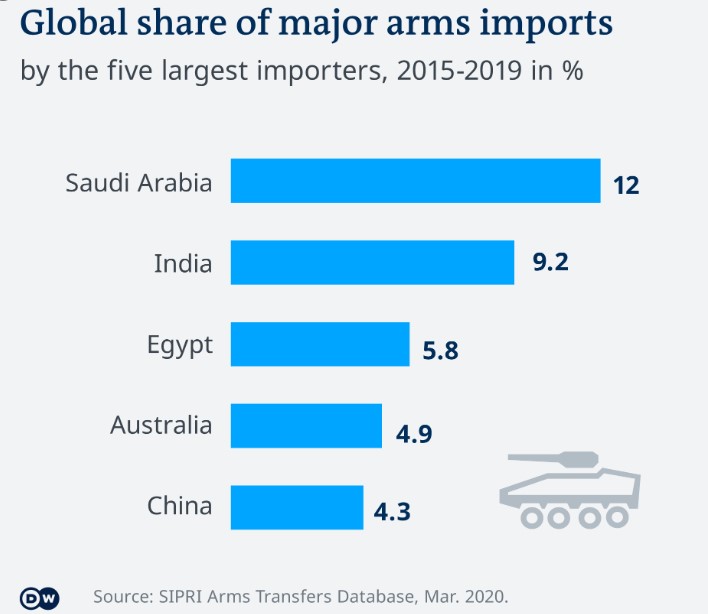India’s Dependence for Defence
- For the most part of 2010 to 2020 The India had the dubious distinction of being the world’s largest arms importer, accounting for about 12% of global arms imports.
- Saudi Arabia jumped to first place in 2018 and 2019, but India still takes over 9% of global imports.
- This external dependence for weapons, spares and, in some cases, even ammunition creates vulnerabilities during military crises.
An opportune moment
- The facts that new Defence Procurement Procedures (DPP) 2020 are under formulation and that we now have a Chief of Defence Staff (CDS) tasked with promoting indigenous equipment in the armed forces, provide a conducive backdrop to having a robust defence manufacturing capacity.
- The decision to notify a list of weapons systems for sourcing entirely from Indian manufacturers, the promise to progressively expand this list and a separate Budget provision for domestic capital procurement will encourage our private defence manufacturers.
- Missile systems such as Akash and Nag, the Light Combat Aircraft and the Light Combat Helicopter, artillery guns, radars, electronic warfare systems and armoured vehicles- are among platforms and subsystems, developed in India and qualified in trials. However, these face hurdles to their induction by our armed forces because of foreign competition.
- The government has promised a time-bound defence procurement process, overhauling trial and testing procedures and establishing a professional project management unit.
- The CDS could also examine them from a tri-service angle, to avoid redundancy of capacities across the services.
How far to push Self-Reliance?
- Corporatisation, including public listing of some units, ensures a more efficient interface of the manufacturer with the designer and end user.
- The thrust for indigenous research and development will coexist with the import of cutting-edge military technologies to obviate near-term defence vulnerabilities.
- At the same time, our defence planners will frame “realistic” specifications for their desired weapons platforms, based on the requirements of India’s defence strategy.
FDI impact
- The liberalisation of foreign direct investment in defence manufacturing, raising the limit under the automatic route to 74%, should open the door to more joint ventures of foreign and Indian companies for defence manufacturing in India.
- It would also sustain a beehive of domestic industrial activity in the research, design and manufacture of systems and sub-systems.
- Our companies, which have long been sub-contractors to prominent defence manufacturers abroad, would now get the opportunity to directly contribute to Indian defence manufacturing.
Analysis: Military budget of India

- The military budget of India is the portion of the overall budget of Union budget of India that is allocated for the funding of the Indian Armed Forces.
- The Indian Army accounts for more than half of the total defence budget of India, with most of the expenditure going to the maintenance of cantonments, salaries and pensions, instead of critical arms and ammunition.
- On 1 February 2020, the Finance Minister of India, Nirmala Sitharaman presented the budget. The allocation for defence during the fiscal year 2020-21 stood at ₹471,378 crores (US$65.86 Billions).
- This amounted to an increase of just under 7%.
- It may be seen from data of economic survey that Defence Budget as a percentage of GDP may appear to be decreasing due to increasing trend in the growth of GDP. However, it is increasing in absolute terms, implying higher spending.
India’s Defence Imports

- India was the world’s second-largest arms importer from 2014-18, ceding the long-held tag as largest importer to Saudi Arabia, which accounted for 12% of the total imports during the period.
- However, Indian imports decreased by 24% between 2009-13 and 2014-18, partly due to delays in deliveries of arms produced under licence from foreign suppliers, such as combat aircraft ordered from Russia in 2001 and submarines ordered from France in 2008.
- Russia accounted for 58% of Indian arms imports in 2014–18, compared with 76% in 2009-13.
-Source: The Hindu





